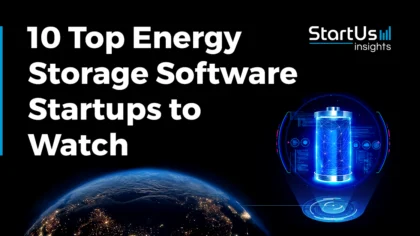Accelerate Productivity in 2025
Reignite Growth Despite the Global Slowdown
Staying ahead of the technology curve means strengthening your competitive advantage. That is why we give you data-driven innovation insights into the energy industry. This time, you get to discover 5 hand-picked virtual power plant (VPP) solutions.
Global Startup Heat Map highlights 5 Top Virtual Power Plant Solutions out of 180
The insights of this data-driven analysis are derived from the Big Data & Artificial Intelligence-powered StartUs Insights Discovery Platform, covering 2.093.000+ startups & scaleups globally. The platform gives you an exhaustive overview of emerging technologies & relevant startups within a specific field in just a few clicks.
The Global Startup Heat Map below reveals the distribution of the 180 exemplary startups & scaleups we analyzed for this research. Further, it highlights 5 energy startups that we hand-picked based on criteria such as founding year, location, funding raised, and more. You get to explore the solutions of these 5 startups & scaleups in this report. For insights on the other 175 virtual power plant solutions, get in touch.
Evergen builds a Distributed Energy Resource Management System (DERMS)
The growth of distributed energy resources (DERs) like solar, wind, and other onsite renewable energy options is democratizing energy production. This allows consumers to sell energy to the grid, further reducing their energy bills. On the business side, utilities are leveraging DERs to create virtual power plants. These supplement energy production from traditional power plants while being more resilient to outages thanks to their distributed nature.
Evergen is an Australian startup that advances renewable energy by integrating DERs. The startup’s solution enables bidirectional communication between grid operators and distributed energy providers to create virtual power plants (VPPs). The startup’s DERMS interfaces directly with batteries from many manufacturers, thereby eliminating the need for additional onsite hardware. This allows operators to aggregate, monitor, and control fleets of batteries.
H Energy offers a VPP Power Brokerage
Virtual power plants compete with each other as well as traditional plants to buy electricity from distributed resources. Operators compete on energy trading platforms to outbid each other for access to extra electricity. This process is inefficient and often costly for VPP companies. To solve this challenge, startups offer power brokerage solutions that allow VPPs to buy power at affordable prices while still encouraging DERs to sell.
South Korean startup H Energy provides power brokerage solutions for energy operators. DERShare, the startup’s cloud platform, enables the management of multiple DERs, big data processing, and real-time optimization, among other functions of a VPP. Powered by AI, the software solution integrates with onsite hardware to ensure optimal operation of assets. Further, the startup uses advanced analytics to optimize power brokerage bids and balance the grid in real-time.
naak enables Cloud-based Energy Management
Unlike traditional power stations, individual units in VPPs span a large geographical area. To efficiently manage energy production across the network, operators require real-time updates. Cloud-based energy management platforms facilitate these updates by collecting, analyzing, and visualizing information. This increases the profitability of a virtual power plant by effectively utilizing individual energy-generating units.
US-based startup naak offers a range of energy management services. The startup’s cloud-based control platform aggregates distributed resources and coordinates response to grid signals. This allows it to provide virtual power plant and auto demand response (DR) solutions. By controlling individual loads at each DER, the startup’s VPP solution optimizes the systems to reduce energy consumption across the network.
Evergeen Smart Power facilitates Energy Technology Integration
Beyond energy generation, virtual power plants also optimize energy consumption at the device level. This enables a more effective demand response management. In individual homes or buildings, a wide range of devices such as solar batteries, electric vehicle (EV) charging units, and onsite heat generators participate in both energy generation and consumption. To capitalize on their potential in balancing the grid, energy startups are integrating these technologies in their VPP solutions.
Evergreen Smart Power is a British startup that advances the integration of DERs in the grid. The startup’s platform integrates and manages a wide range of energy technologies, including batteries, EV chargers, and heaters. It reacts to grid conditions in real-time to increase or decrease energy consumption or generation. By leveraging domestic devices for VPP, it allows end-consumers to participate in DR as well as lower their energy bills.
DieEnergiekoppler builds a VPP 2.0
With the advent of smart grids and smart home devices, energy consumption can be monitored at the level of individual appliances. This opens up new possibilities in making virtual power plants more robust. Already, startups use technologies such as blockchain and the Internet of Things (IoT) to control energy use by these devices. This adds value to VPPs by optimizing energy use to provide the highest value for both end-users and operators.
German startup DieEnergiekoppler offers a technology-agnostic form of VPPs. Flexibility Plant, the startup’s VPP 2.0 product, enables the integration of small energy devices. It features swarmBOX, a self-learning control box that manages energy generation and production in a building, and swarmHUB, an interface for energy trading across the grid. The startup’s solutions automate and standardize the operation of a VPP while making it technology-agnostic.
Discover more Energy Startups
Energy startups such as the examples highlighted in this report focus on smart grids, grid balancing, and transactive energy. While all of these technologies play a major role in advancing the energy industry, they only represent the tip of the iceberg. To explore more energy technologies, simply get in touch to let us look into your areas of interest. For a more general overview, you can download our free Energy Innovation Report to save your time and improve strategic decision-making.









